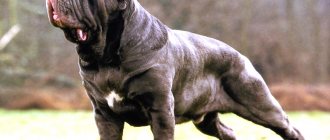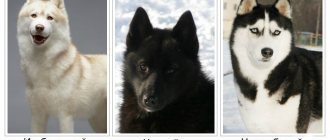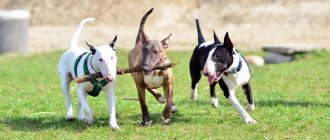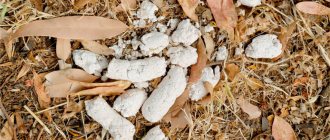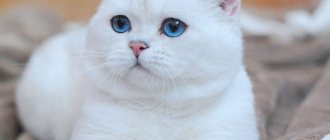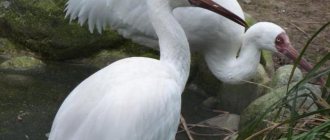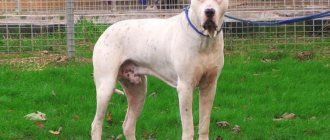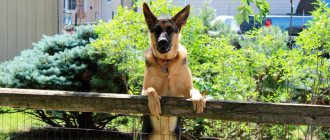History of the Dogo Argentino breed
Despite the fact that the breed is quite young and has existed for about a hundred years, its history began long before that, namely from the 16th century - the stage of the Spanish Conquest. Along with the desperate desire to seize the lands of the New World, the army “armed itself” with huge, ferocious dogs that kept the local population in fear because of their indomitable temper and rare bloodthirstiness. Basically, these animals represented a now defunct breed - the Cordoba fighting dog. However, among the imported ones there were also more peaceful Alan-Spanish bulldogs, which are common in their homeland to this day.
Dogo Argentino
It is worth noting that in those troubled times, fighting pits were popular, in which dogs fought to the last drop of blood. The city of Cordoba became the center of this business. Wanting to acquire new specimens that would be distinguished by extreme ferocity and endurance, the Spaniards crossed bull terriers and Alanos. This union gave birth to the Cordoba fighting dog, which later became a legend of bloodthirsty battles, since in most cases it snatched victory from its opponent with its teeth (and often literally). The breed practically did not participate in mating, since even dogs of different sexes showed hostility towards each other.
In the 18th century, an economic crisis reigned in the British Isles, and the state was forced to conduct active foreign trade. Among its partners was Argentina, which at that time had already changed the status of a Spanish colony to an independent confederation. Along with the goods, fighting dogs also came to the lands of Foggy Albion: staff bulls, bull terriers and the above-mentioned Cordovans. Unfortunately, the latter never took root in Europe. Over time, the fighting dogs of Cordoba disappeared completely, but before that they managed to make a significant contribution to the creation of a new breed. This is what the Dogo Argentino became.
Dogo Argentino (the second name of the dog) is the triumph of Antonio and Augustin Martinez, the sons of a wealthy landowner. Avid hunters used the Cordovan dog as an assistant - an extremely ferocious and bloodthirsty creature. At the same time, the young men could count on the participation of a maximum of two animals in baiting: due to their pugnacious nature, Cordoba’s fighting dogs did not want to gather in a pack and work as a team. The realization of this fact was the first bell that foreshadowed the appearance of the Dogo Argentino.
Dogo Argentino puppy
Work on creating the breed began in 1925, when Antonio had barely crossed the threshold of adulthood. The Martinez brothers set themselves a seemingly impossible task - to breed a dog with outstanding physical characteristics, excellent instincts and an attractive exterior. At the same time, it must have a balanced character, which does not imply aggression towards humans and other dogs.
Wanting to create a solid foundation for the new breed, Antonio and Augustin purchased ten Cordoban females - not as angry as males - and began to breed them with dogs in which they saw the desired qualities: speed, hunting instincts, height and sense of smell. Worthy breeds for mating include the Dogue de Bordeaux, the English Pointer, the Irish Wolfhound and the Great Pyrenees. It is worth noting that long before the positive result of his canine experiment, Antonio formulated the first breed standard, based on his own vision.
The brothers received tremendous support from their father, who hired people to care for the dogs while his sons were away from home. In addition, friends also showed interest in the new breed, who often fed the animals and made voluntary financial contributions. Everyone wanted to acquire a representative of a new hunting breed that could work in the company of its relatives and would not show excessive ferocity towards them.
For thirty years, Antonio and Augustin polished the exterior of the “Argentine”. At the same time, two branches of the breed were formed: the Araucana (from crossing with the Dogue de Bordeaux) and the Guarani (offspring from the Irish wolfhound). However, the prototype of the modern Dogo Argentino was a hybrid of two lines, so they have not survived in their pure form to this day.
Dogo Argentino with cropped ears
The death of Antonio Martinez while hunting in the mid-20th century brought chaos to the selection of the breed. Most breeders began uncontrollably crossing dogs, which significantly spoiled the geno- and phenotype of the Dogo Argentino. Only Augustine managed to return the process of dog breeding to its previous course. By the way, he was also involved in popularizing the breed. Martinez Jr. worked at the Ministry of Foreign Affairs and presented the ambassadors with an unusual but very valuable gift - Dogo Argentino puppies. The man believed that this kind of presentation is one of the most effective ways to glorify dogs throughout the world.
And so it happened: already in May 1964, the breed was officially registered by representatives of the Canine Federation of Argentina. Nine years later, the international organization FCI recognized the Dogo Argentino breed standard. At the same time, the breed gained popularity in European countries, mostly thanks to Otto Schimf. The Austrian dog handler was fascinated by the dogs' proud posture and played an important role in their spread throughout European territory.
Today, the Dogo Argentino is the only officially registered breed of the “Silver Country”. Its representatives combine the best qualities of their ancestors: courage, hunting instincts, flair, strength, size - and all this is in harmony with the playfulness and good-natured nature of the animals. However, the latter features are still questionable in some countries of the world. Thus, Ireland, New Zealand, Australia and Great Britain prohibit the breeding of Dogo Argentinos, since this breed is considered one of the most dangerous in the world. This is not true: dogs do not show ferocity towards humans and do not take part in dog fights due to the lack of aggression towards their tailed relatives.
History of the breed
Dogo Argentinos cannot boast of antiquity; the history of these dogs is very short, it is calculated not in thousands, but only in tens of years (about 70 years). The beginning of breeding work on improving Argentines was laid in the twenties of the twentieth century by Dr. Antonio Martinez and Augusto Martinez.
In the process of establishing the Dogo Argentino breed, dozens of different types of dogs were used. Each breed that was used in breeding work made its own specific contribution:
1. Cordoba Dog – power and fearlessness, the will to win. This breed was taken as a basis in the process of working on the Argentines. 2. The English Pointer has a unique scent and hunting instinct. 3. Bull Terrier – the ability to fearlessly confront even those opponents who are significantly larger than the Great Dane. 4. Irish Wolfhound – lightning-fast reaction, increased speed qualities. 5. Bulldog - impressive size, wide chest, death grip of massive jaws. 6. Great Dane – large dimensions, particularly height. 7. Dogue de Bordeaux - large fangs, powerful jaws. 8. Spanish Mastiff – attractive character, charisma. 9. Great Pyrenees Mountain Dog – white coat color, performance, endurance.
The formation process was completed in 1947. The standard was also introduced in that year. At the end of spring 1964, the breed was officially recognized. It was in the seventies that dog handler Otto Schimf, appreciating all the advantages of Dogo Argentino, brought them to Europe. Beautiful and powerful dogs quickly gained popularity in France, Italy and other countries.
This species is part of the Molosser group, although there was a period when they were classified as hounds. Initially, Argentine breeders sought to create a hunting dog ideal for the conditions of their native country.
Such a dog was supposed to hunt wild boars, pumas and other large animals. Then the Great Danes began to be used as bodyguards and established themselves as talented show dogs. Recently, most representatives of the breed have become excellent companions and faithful pets.
Appearance of the Dogo Argentino
Dogo Argentino and Donkey
Dogo Argentinos are large breeds. These animals are built very proportionally and have a tightly built physique. The muscles have clear contours that are noticeable even under the dog’s skin.
According to the FCI standard, males should reach a height of about 62-68 cm. For Dogo Argentino females, other parameters are defined - 60-65 cm. If we talk about the dog’s body weight, it varies between 40-55 kg.
Head and skull
The powerful and strong head of the animal is distinguished by the almost complete absence of subcutaneous fat, which is “compensated” by the predominance of muscles and bones. There are no sharp corners or deep depressions. The intersection of the lines of the muzzle and forehead is noted. The massive skull appears convex due to the developed muscles of the jaws and neck. The zygomatic arches are shifted from its apex, thereby forming a small depression in the temple area. The central and occipital parts of the skull are poorly defined.
Muzzle
The Dogo Argentino's muzzle is distinguished by consistent proportions: its length is not much greater than its height. The transition from the forehead to the nose is slightly pronounced, while the muzzle itself tapers slightly towards the end. A slightly arched top line is a distinctive feature of all representatives of the breed. The Dogo Argentino's nose is raised and gives a slight curve to the muzzle. It has wide open nostrils and black pigmentation. The dog’s lips also have the latter characteristic – short, moderately fleshy, with free edges.
Dogo Argentino muzzle
Ears
The appearance of the Dogo Argentino's ears depends on whether they are cropped or not. The only common feature is a high seating position. Cropped ears have the shape of a triangle, and their length is no more than half the length of uncropped ears (flat, wide, with rounded ends). At the same time, the latter can rise slightly when the Great Dane is angry or alarmed by something. Both cropped and undocked ears are spaced quite widely apart.
Eyes
Great Danes at an exhibition
Almond-shaped eyes have hazel or dark pigmentation. A black eyelid rim is desirable, but its absence is not considered a defect. The eyes are spaced widely apart and set very deep.
Jaws and teeth
The Dogo Argentino's jaws are positioned relative to each other so that they form a scissor bite, but a straight bite is also possible. Smooth and large teeth with uniform arches “sit” firmly in the gums. The breed standard requires a complete dental formula.
Neck
The thick neck of the Great Dane is characterized by a pronounced scruff and lack of dewlap. Folds are visible on the throat.
Frame
Has a rectangular format. The muscular, wide back extends into a developed croup, the width of which coincides with the width of the chest. The latter provides significant tidal volume due to its size and structure. The belly does not sag.
Tail
Dogo Argentino from the back
The long tail of the Dogo Argentino is saber-shaped and quite wide. Together with the upper line of the body, it forms an acute angle of 45 degrees. When walking and walking, the dog holds its tail at the level of its back or slightly higher.
Forelegs
They are distinguished by a developed musculoskeletal system. The shoulders are distinguished by moderate muscle relief. The animal's elbows are tightly pressed to the ribs and turned toward the back. The vertically positioned forearms turn into long wrists, and these, in turn, into flat metacarpus. Round paws have crowded powerful toes.
Hind limbs
Their slight inclination, strength and muscularity determine the dog's good drive and characteristic gait. Strong hips are connected to the joints at an angle of 100 degrees. They are not much longer than the animal's muscular legs. The metatarsal bones are oval in shape and located at right angles. The hind feet are not as large as the front feet, but the toes are shaped in a similar manner. It is worth noting that dewclaws are removed in most cases.
Movement style
Every step of the Dogo Argentino demonstrates confidence and agility. It is quite measured, but becomes more sweeping when the dog moves to a trot. The gallop perfectly emphasizes the natural strength of the animal. Balanced, harmonious, self-possessed - this is how one can describe the movements of a Great Dane.
Coat
The length of the guard hair does not exceed 2 cm. The density of the coat is determined by the climatic conditions in which the dog lives. In southern specimens, the skin is visible through the coat, while northern representatives of the breed are the happy owners of thick wool, often with undercoat.
Color
The Dogo Argentino is characterized by a white color. A black spot near the eyes or ear of the animal is acceptable, but a pure color without points is still preferable.
Dogo Argentino with black spot and pure white
Possible defects
Breed defects include:
- gait that does not meet the standard;
- weakened pigmentation of the eyes and nose;
- uneven skin color;
- unstable nervous system;
- keeled or barrel-shaped chest;
- incomplete dental formula;
- weak muscular system;
- eversion or inversion of the eyelids;
- flattened ribs;
- long shins;
- flakiness.
Any deviation from the breed standard is regarded as a defect.
If we talk about disqualifying defects, the most common among them in Dogo Argentino are:
- the presence of points in places atypical for the standard;
- aggressive or cowardly behavior;
- uneven development of the jaws;
- excessively long guard hair;
- lack of nasal pigmentation;
- blue eye pigmentation;
- heterochromia;
- cryptorchidism;
- deafness.
Description of the Argentine Mastiff breed
At first glance, the Great Dane looks intimidating. But behind the formidable appearance lies a good-natured and sympathetic animal. His devotion to his owner and ease of training make him even more desirable for dog lovers.
For a long time, employees of the international canine organization FCI could not decide which category to classify the animal of this breed into. Initially they equated it with the mollos, but then it was decided to transfer it to the hound breed. But, having examined the special characteristics of the animal, they returned the Great Danes to their original appearance.
The breed has the qualities of several groups of dogs at once. It contains genes from service, hunting and fighting animals.
The breed standard implies the following characteristics:
- The head has a massive structure. The transition from the muzzle to the neck is clearly defined. The dimensions of the muzzle are almost equal to the length and width of the skull. Thanks to this, the dog can hold large game in its mouth. The head has virtually no subcutaneous fat. Its absence is compensated by the presence of muscles and bones. Because of this, there are no sharp corners or depressions. The skull appears massive due to well-developed jaw and neck muscles.
- The eyes are buried in the muzzle. At the same time, they are widely spaced. The color is brown from light to dark shades. Brown eyes are preferred. Animals with a light tint most often have difficulty hearing. The eye shape is almond-shaped. The eyelids have a dark rim. Its absence is not considered a defect.
- The bite is scissor-shaped, and may be straight. The lips are fleshy and thick. There is no transition to the wings. The teeth are strong and even. They are firmly planted in the gums. According to the standard, the dental formula must be complete.
- The neck is thick. The scruff is clearly defined, but there is no dewlap. There are folds in the throat area.
- The ears are cropped, triangular in shape, and stand erect. There are countries in which ear cropping is prohibited; then they have an elongated shape with rounded tips and hang down. Regardless of whether the ears are cropped or not, they are set high and wide apart in relation to each other.
- The tail is long, wide, straight, and looks like a saber. The top line of the body and tail form an angle of 45 degrees. When walking, it is located at or slightly above the back.
- The coat is coarse, short in length, uniform throughout the body. The Dogo Argentino characteristic suggests a shortened length in the area of the paws, muzzle and head.
- The paws are round and powerful. The slight slope of the rear contributes to a strong push. The movements are confident and dexterous. The step is measured, when moving to a trot it becomes sweeping. Galloping shows the dog's natural strength.
You can see the characteristic features of the Great Dane in more detail in the photo.
Size and weight
The size of the animal depends on the gender. The male reaches a height at the withers of 60-68 cm . The knot about 3 cm shorter . average weight is 43-45 kg .
Color and coat type
The guard hair reaches a length of 2 cm. The density depends on the climate in which the animal lives. In southern countries, dogs have short hair, and you can see the skin through it. The northern representatives of the breed have long, thick hair, often with an undercoat.
The Dogo Argentino breed is a pure white dog. The breed standard implies a deviation - the presence of black spots in the area of the eyes and ears. Pigmentation should be no more than 10% of the head color.
If puppies with a significant deviation in color appear in the litter, they are discarded and not used for breeding the breed.
Photo of an adult Dogo Argentino
Character of the Dogue de Bordeaux
The Dogue de Bordeaux's intimidating appearance is the main reason why people consider these dogs to be aggressive and dangerous. Once you discard stereotypes, the dog will appear different to you: playful, faithful and loving. There is no punishment worse for an animal than loneliness. Lack of attention negatively affects the behavior of Bordeaux, so do not be surprised if, upon returning home, you are greeted with damaged furniture, broken vases and an overturned bucket of water.
Dogue de Bordeaux with a childRepresentatives of the breed are completely devoted to the family in which they live, and especially to their owner. Sitting down at your desk or sitting comfortably to relax on the sofa, don’t be too lazy to put your hand down: after a few minutes, your pet’s wet nose will definitely bury itself in it. As soon as you decide to leave the room, the dog will immediately follow you, no matter how sound and comfortable its sleep was.
The Dogue de Bordeaux behaves similarly on the street. When walking without a leash, the animal prefers not to stray far from its owner so as not to lose sight of him. To allow your pet to stretch its paws, take it for a light jog in a city park. This will not only cheer up the dog, but will also provide you with a little peace of mind in the evening: a tired Great Dane will take a place on his favorite bedding, and will not cause destruction in order to throw out pent-up energy.
"Bordos" cannot be called a family dog, but still he easily gets along with children over six years old. The fuss and noise of a younger child is perceived by the Great Dane as a potential threat. In addition, the huge dimensions of the animal make it quite dangerous: when passing by, a Dogue de Bordeaux may inadvertently push your child or fall on him during play. Dog handlers recommend postponing the purchase of a dog until the children go to school, but even in this case it is necessary to closely monitor the relationship that develops between the child and the Bordeaux. The slightest conflict should be nipped in the bud.
Cohabitation of a Great Dane with other pets is possible under certain conditions. A properly raised dog will not bare its teeth at its fellow dog, but the same cannot be said about male dogs, who most often develop competitive relationships with animals of the same sex. The Dogue de Bordeaux gets along quite easily with a domestic cat, but when it sees a stranger, it will certainly give chase and, most likely, will delight you with its “prey.” It is not recommended to let your Great Dane off the leash while walking if you do not want to become an accomplice in a bloody massacre. Representatives of this breed have an overly heightened hunting instinct, so you shouldn’t take risks, even if you are confident in the pet’s calmness.
A socialized Dogue de Bordeaux will not attack a stranger
The main thing is to treat the giant with respect and not bother him with unnecessary attention. Listen to your dog's grumbling: this is often a warning signal that could lead to an attack.
Representatives of the breed make excellent guards. “Bordeaux” will not allow entry into the territory entrusted to them without permission. Even when a stranger appears, the Great Dane will not immediately rush into pursuit. First, the animal will try to properly scare the unwanted guest with its menacing appearance and only then will it show strength. If it comes down to protecting the family, the Dogue de Bordeaux will fight to the last and will most likely emerge victorious.
An interesting feature of the dog’s character is its intolerance to the smell of alcohol. Refrain from walking your Dogue de Bordeaux during city festivities: meeting a drunk person can cause your pet to become irritable. Under certain circumstances, the Great Dane attacks, and it is quite difficult to restrain a dog of this size - even on a leash.
Dogue de Bordeaux with a cat
Dogue de Bordeaux with a small dog
Character of the Dogo Argentino
This breed is a clear illustration of the saying that appearances can be deceiving.
Of course, the Dogo Argentino gives the impression of a ferocious killing machine. Powerful jaws with sharp teeth, a superbly built body, impressive dimensions and a menacing appearance clearly do not contribute to friendship with the “Argentine”. However, in fact, this is an affectionate animal that dotes on its owner and his family. By choosing a representative of this breed, you automatically become a friend and companion of a discreet aristocrat who will never bark without a reason and can behave with dignity in any society - be it human or canine. The Dogo Argentino is demanding only in one thing - special attention to his person. These dogs cannot imagine communicating with their owner without physical contact, so be prepared for the fact that this snow-white big guy will sooner or later settle down on your lap, quietly grumbling, and soon begin to snore, dreaming about a juicy steak. If this pet behavior is unacceptable, you should consider a different breed. Otherwise, you will make not only yourself unhappy, but also your innocent dog.
Dogo Argentino with baby
Dogo Argentino playing with a ball
Behind the tenderness and affection of the Dogo Argentino lies his independent and somewhat dominant character. These animals are not the best option for novice dog owners. Dogo Argentino is not suitable for those people who prefer to spend their free time in front of the TV or with their favorite book in their hands. The Dogo Argentino needs regular exercise to stay in shape, as well as to improve its hunting and sporting abilities. Forget what it’s like to bask in a warm bed until noon. With the advent of the “Argentine”, your usual routine will take a sharp turn and give you a lot of new impressions from communicating with the animal.
Contrary to the misconception, the Dogo Argentino's attitude towards strangers is very patient, although wary and skeptical. However, with proper upbringing and socialization of the animal, it will quickly thaw in response to a gentle scratching behind the ear. Despite this, Dogo Argentinos are excellent watchmen, who will bark loudly in case of illegal entry into the territory entrusted to them. It is worth noting that these dogs prefer to first scare the uninvited guest and rush to attack only in case of emergency.
Dogo Argentino bitch and cable
Representatives of this breed are often used as bodyguards because of their amazing affection for their owner. The Dogo Argentino will protect the people dear to him without the slightest hesitation - even if the enemy is several times larger. Throughout the history of the breed, there have been cases where dogs fearlessly entered into battle with ferocious predators and often emerged victorious.
Dogo Argentinos get along well with children. Your child will not find a more loyal and cheerful friend! However, be careful: during play, the dog does not evaluate the limits of its strength and may accidentally push the child. This rule also applies to Dogo Argentino puppies, which, like adult animals, are large in size.
As for sharing a Great Dane with other pets, this is extremely undesirable. Don't forget about the developed hunting instincts of this breed! While the Dogo Argentino may get along with dogs, in the case of cats the situation will take an unexpected turn. An exception will be animals with whom the Argentino grew up, but this does not apply to some dogs. Decorative rodents and winged animals should not be in the same territory as the dog.
Representatives of this breed are very unpretentious. They do not need soft feather beds and expensive harnesses. Do you want to see your pet happy? Give him the opportunity to stretch his paws! The Dogo Argentino is content with both a short jog and a walk to the other end of the city. If you like to run in the morning, a dog will be a pleasant company. Leave your pet bored at home - and then your apartment will be in trouble: the Dogo Argentino will decide to throw out its energy, and this is unlikely to be to your liking.
This is Love
And this is a very strong love
Pet character
Representatives of this breed are characterized by a high level of activity, mobility, strength and endurance..
They are brave and have a developed fighting and protective instinct, but are absolutely not aggressive. The manifestation of aggression is a significant defect, which is considered a disqualifying characteristic; such dogs are not allowed to be bred or participate in exhibitions.
Dogo Argentinos are devoted to their owner and his family, and behave affectionately and friendly with them . They treat strangers with distrust and wariness, but if they do not behave aggressively and do not pose a threat, they quickly show sympathy and friendliness.
Otherwise, these dogs bark, announcing the visit of a stranger, and without hesitation they come to the defense of their owners.
Representatives of this breed need attention and care, they need to be walked and exercised, providing the necessary level of physical activity - this helps them keep fit.
Expert opinion
Kozhevin Semyon Kirillovich
Expert dog handler.
Dogo Argentinos are smart dogs and training them is not a problem if you approach this issue correctly. They tend to dominate and in the first few years they will try with all their might to take a leading position in the house, so inexperienced dog breeders are better off turning to professional dog trainers and undergoing OKD. Despite the fact that modern representatives of the breed are not created for fighting, their strength and power cannot be underestimated - without proper upbringing they can pose a serious danger to others.
Education and training
Representatives of this breed have all the necessary qualities for successful and fruitful training. The Dogo Argentino has a flexible intellect and ingenuity that allows the animal to solve various problems - from fishing a ball out of a laundry basket to opening unlocked room doors. Like any breed of dog with an independent and dominant character, the Dogo Argentino needs proper education and correct socialization. Be patient and be prepared for the fact that you may need help from more professional dog breeders.
When resorting to independent training, remember: your primary task is to emphasize your leadership. When the command is successfully completed, praise the dog and reward it with its favorite treat. Be sure to follow the main rule: do not raise your hand to your pet! Such training will not bring positive results, and the animal will become angry with you and become withdrawn. Love and affection are the keys that will open the door to the heart of the Dogo Argentino.
Hunting
The Dogo Argentino dog has an excellent sense of direction. It is used for hunting large animals common in South America. For example, for a wild boar, lion, jaguar, puma.
Thanks to its powerful tail, the Great Dane chases prey very quickly and competently. Strong jaws protect the dog in a fight with the beast. This is a very hardy pet. Only the Dogo Argentino can chase an animal for a long time across Argentina. The peculiarity of this territory is that it consists of fields, dense forests, swamps, thickets of bushes, mountainous slopes, etc. The Great Dane doesn't care what the weather is like. It will run equally fast in pouring rain and in the scorching sun.
Hunting with a Dogo Argentino is an unforgettable experience. This dangerous entertainment is still common today. A whole pack of dogs takes part in the hunt. Among them are 2-3 Dogo Argentino males and 6-8 hounds. They silently and passionately pursue their prey. After a long pursuit and overcoming various natural obstacles, the pets still have enough strength to fight with their prey. They attack the beast and hold it until people with guns arrive. In the 21st century, hunters switched to SUVs. After the process is completed, the tired pack is taken home by car.
Dogs are specially trained to hunt large animals. To do this, they are brought to pens where real wild boars and lions run. Dogs fearlessly rush at predators. The owners are watching this. Dogo Argentino puppies are taught the wisdom of hunting large animals from an early age. By the way, in South America you can buy a professional pack of dogs for hunting. Its cost starts from several tens of thousands of dollars.
Care and maintenance
The Dogo Argentino requires minimal but constant care, the lion's share of which falls on the dog's snow-white coat. It should be combed no more than twice a week using a rubberized mitten or brush. During the molting period - autumn and spring - the procedure is repeated daily. Thorough brushing removes dead guard hair and, in addition, pleases the dog with a pleasant massage. It is worth noting that the Dogo Argentino is not the most suitable breed for squeamish and overly clean people: the dog sheds profusely, so you will have to regularly clean clothes and furniture of hair. Think about a different breed if you are allergic: white “needles” in all corners of the apartment will be a good reason to burst out with a loud “Apchhi!”
It is highly not recommended to give your pet a weekly bath: once a month is enough. To do this, use mild shampoos, preferably for light-colored dogs. Make sure your apartment is completely draft-free after bathing your Dogo Argentino. Otherwise, the animal may catch a cold.
Despite the fact that a dog’s ears can be cropped for up to three months, they also need your attention. Once a week, blot your ears with a cotton pad soaked in warm water.
Important: wax and pungent odor should be absent, and the ears should maintain a healthy pink tint.
The animal's eyes also need attention. Remember to gently wash them with chamomile tea using a small piece of soft, lint-free cloth. Discharge, noticeable redness, swollen eyelids and excessive tearing are reasons to consult a veterinarian.
To shorten nails, purchase a special tool for large dog breeds and a file that will help smooth out sharp edges and nicks. The procedure is repeated once a week. After a walk, it is recommended to carefully examine your pet's paws. Have you noticed any cracks appearing on the pads? Rub vegetable oil into their surface and give it to the dog in the amount of one teaspoon per day.
Continue…
Last on the list, but by no means least important, are the animal’s teeth. They need thorough cleaning with a special paste twice a week. Use a finger attachment or a brush.
Note: to prevent the appearance of tartar, it is recommended to include solid food and fresh tomatoes in your dog’s diet. This will help maintain your pet's oral health.
Your pet's nutrition should be balanced and correct from puppyhood. Please note that Argentinean babies have an enviable appetite and can quickly gain weight if you indulge their pitiful glances and squeals. In general, you should be guided by the fact that the volume of food consumed should not exceed 7% of the puppy’s total weight. Moreover, after six months, it is recommended to switch to two meals a day instead of feeding your pet four times a day.
Focus on one of two possible types of food: natural or ready-made high-quality food. It is strictly forbidden to mix both options if you do not want your dog to develop problems with the gastrointestinal tract.
Prepared food should include grains and vegetables. The absence of chicken meat is preferable because it is allergenic for most breeds. Natural food should be served fresh. Typically, it is based on boiled offal and lean meat, as well as low-fat milk. Dogo Argentino can also be given boiled sea fish without bones. Include vegetables and fruits in your dog's diet depending on the season.
Dogo Argentino should not eat the following foods:
Dogo Argentino resting
- river fish in any form;
- baked goods with yeast;
- grapes and nuts;
- smoked products;
- tubular bones;
- fat meat;
- sweets;
- legumes
It is recommended to feed the Dogo Argentino from a stand: this way the animal will maintain its proud posture. There should always be fresh water in one of the bowls. Please note that the portion is eaten by the dog in a maximum of twenty minutes. If there is too much food, put it aside until the next feeding.
Dogo Argentino in the fog
How to properly care
Dogo Argentinos do not require grooming. To maintain your pet's attractive appearance and health, you just need to follow simple hygiene rules.
Wool and bathing
The coat should be brushed 2-3 times a week with a soft brush with natural bristles, and during shedding, use a furminator..
If your pet lives in an apartment, then after every walk, especially in rainy weather, you need to wash its paws and belly.
Dogo Argentinos should be fully bathed no more than once a quarter, using a hypoallergenic shampoo appropriate for their coat type. Washing more frequently can cause loss of the fat layer needed to protect the top layers of skin in winter.
Ears
Twice a week you need to wipe your pet's ears with a cotton pad soaked in a special lotion to remove excess wax and dirt.
Claws
With regular active walks, the claws wear down on their own . If this does not happen, as they grow, they need to be shortened with a guillotine nail cutter.
Eyes
No additional eye care is required; they should be moderately moist . In case of severe souring, they need to be washed with warm boiled water; if this does not help, contact a veterinarian.
Teeth
To prevent the formation of plaque and tartar, once a week you need to brush your pet’s teeth with a special brush and toothpaste or tooth powder.
Health and Diseases of the Dogo Argentino
Representatives of this breed are distinguished by their good health (especially in comparison with dogs of similar sizes). Most often, Dogo Argentinos suffer only from deafness - partial or complete. In the second case, the dogs are euthanized because it is impossible to predict and control their behavior.
Other common Dogo Argentino diseases include:
- lack of thyroid hormones;
- skin diseases;
- joint dysplasia;
- glaucoma;
- allergy.
Price
You can buy a Dogo Argentino puppy in specialized nurseries. There are several of them in Russia. They are located in large cities. You can also contact private breeders.
Dogo Argentino puppies are not cheap. The cost starts from 15-20 thousand rubles. However, for such days they sell babies with some deviations in appearance. An elite dog from excellent parents can be purchased for 45-70 thousand rubles.
The Dogo Argentino can win the heart of any person. But for this, the dog must be properly raised. Raising her is not easy. Firmness, balance, calm and patience are required. It is recommended that only experienced dog breeders own this snow-white beauty.
How to choose a puppy
If you want to get a healthy pet, it is best to purchase a baby from a breeder who can provide you with a passport and documents confirming that the animal meets the breed standard.
Dogo Argentino puppy with mom
It is preferable to wean the puppy from its mother at one and a half months. When meeting a toddler, pay attention to the conditions in which he is kept. The place should be dry, fairly sunny and ventilated, but without drafts. Your future pet is the baby who has a healthy appetite, activity and a desire to get involved in the next fun game. An isolated and cowardly puppy is a bad purchase.
Special attention should be paid to the appearance of the animal. The Dogo Argentino's coat should be shiny, its nose should be moist, and its ears should be clean. Guided by the results of these simple observations, you can choose the healthiest and most affectionate puppy who will become your most loyal friend.
Tips for choosing a puppy
Purchasing from a kennel guarantees you a puppy that will be a true Dogo Argentino in appearance and character. The pedigree of the parents of the RKF-FCI sample, a test for dysplasia, a veterinary passport, a puppy card and a brand - this is a set of a purebred puppy that will grow into a dog from the exhibition photographs.
A good breeder will not sell you a puppy under two months old, but he will be happy to give advice on the characteristics of the breed and tell you about his dogs. The area where Dogo Argentino puppies are kept should be tidy and their mother should not look emaciated.
You should not choose a cowardly and downtrodden puppy. Better pay attention to a cheerful, playful, moderately well-fed baby with a good appetite. The fur is white, the skin is without red spots, the nose is wet and shiny, and the ears are clean and without an unpleasant odor.
Puppies come in show, breed and pet class. If you are not going to participate in exhibitions, a pet-class dog is suitable for you. Usually this is a puppy with disqualifying defects in appearance or simply a dog that meets the breed standard, but the breeder sees that the puppy cannot get a higher rating than “very good” at the show.
Show-class Dogo Argentino puppies are the future owners of exhibition cups, diplomas and rosettes. At the same time, a show dog will not always be a great producer. Breed class are pedigree dogs that can participate in breeding. They can often produce high-quality offspring when mixed with the right bloodlines and successfully mated.
But if you buy a two-month-old puppy, the breeder can only guess what this dog will be like, and everything can change. A puppy of breeding class, who is nothing special, can grow into a champion, but a puppy, on whom great hopes were placed, will develop some significant flaw.


